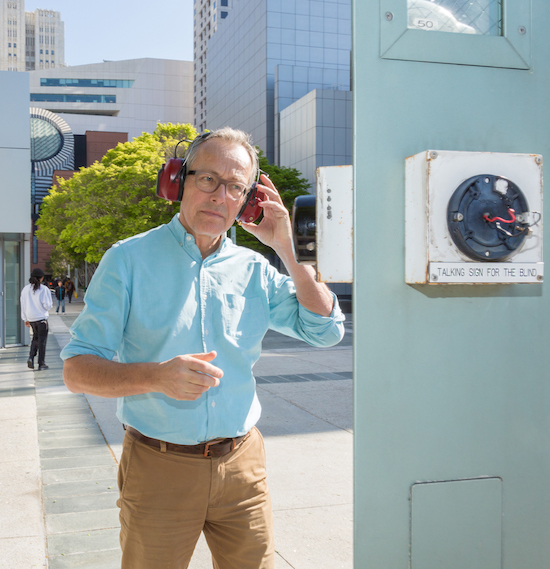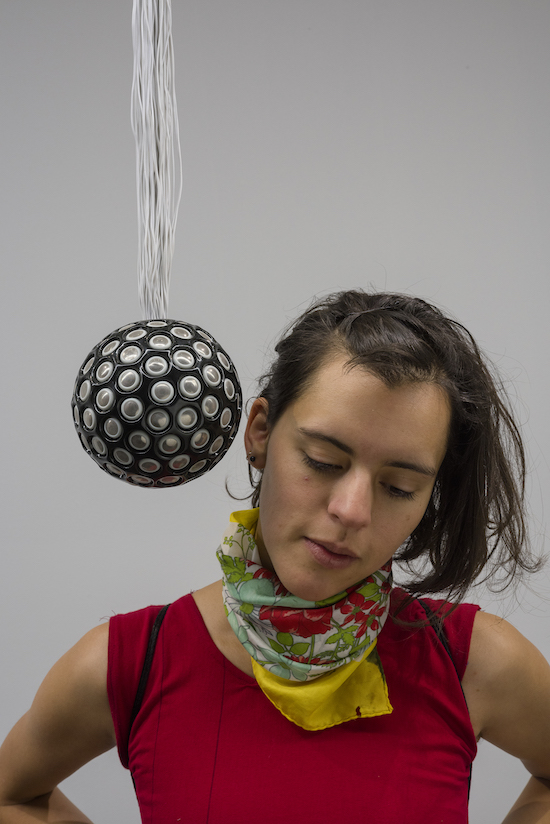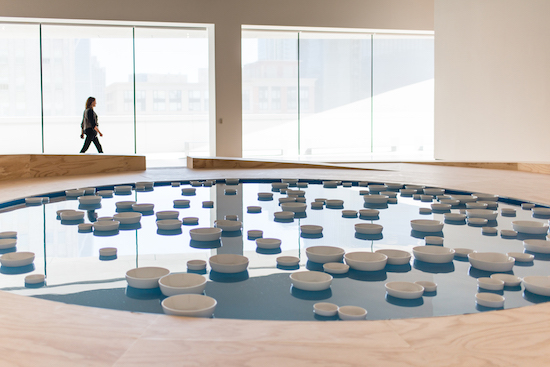Céleste Boursier-Mougenot, clinamenv.3, 2012–ongoing; porcelain, plywood, polyvinyl chloride, water pump, water heater, water; courtesy the artist and Paula Cooper Gallery, New York; © Céleste Boursier-Mougenot; photo: CharlesVillyard, courtesy SFMOMA
Soundtracks is designed to look at the relationships of sound and space in contemporary art. It seeks ways of playing with the polite quietness of contemporary galleries largely designed to suit visual practices, a language of neat-white walls and polished concrete floors offering a reverential aura to display the important markers of our creative culture. Sound, echoing off those same harsh surfaces, would break that seriousness and distract an attentive audience from their deep, worthy contemplation. Or so the consensus seems to be throughout the public and commercial galleries which create and curate these spaces of silence.
There have always been ongoing problems with displaying sound art: overlapping noises making it hard to clearly listen to a single work; an inability for visitors to concentrate on the works as the percussive detritus of footsteps, chattering, and doors compromise the clarity; or the need to sit in a prescribed space and tether yourself via headphones to a particular part of the gallery. However, new technologies – wireless headphones, sound buffering devices, targeted speakers – which can help solve these issues mean that coupled with intelligent curation it is now possible to embed sound art throughout exhibitions to broaden the understanding and relationship to other areas of contemporary art. Some of these technologies are employed in Soundtracks – though to be on the safe side the accompanying leaflet does state: “Some works can be heard before they are seen, blending in with ambient noise amid the aural environment of people walking through the museum.”
The cynic might infer that by appearing to incorporate what are normally considered problems into the design of the exhibition SFMOMA are admitting defeat to the idea that sound art can be exhibited neatly and concisely in traditional gallery spaces. The more generous reader may see it as a step in breaking down those gallery conventions of silence and reverential looking. In truth, it does both.
There are works on show which utilise this new tech such as Christina Kubisch’s Cloud, an entangled form of red electrical cable which emits an equally enticing and unnerving throbbing when walked around and approached wearing wireless electromagnetic induction headphones. Invisible forces manifested directly into your brain encourage a participatory exploration of the whole space, pulling and propelling the visitor around the architecture and object.
Another, Jacqueline Kiyomo Gordon’s Inside You Is Me, is a sculptural installation. Termed a “configurable sound system” it utilises materials including silicon, fabric, wool, and vinyl within aluminium frames to explore how acoustic engineers absorb, block, reflect, and diffuse sound. Originally designed to be used and affected by dancers and live sound makers, the work is “activated” by Gordon for the exhibition duration with sound files – though one can’t escape the dryness and lack of energy of the piece when it remains a static sculpture with ambient sounds filling the space, barely being affected by the materials or surfaces of the work.

Christina Kubisch,Electrical Walks San Francisco,2017; walk in and around SFMOMA with electromagnetic induction headphones and map; San Francisco Museum of Modern Art, Accessions Committee Fund purchase; © Christina Kubisch; photo: Katherine Du Tiel
This sense of the visual component of each work dominating the sound element is an issue which lingers throughout the exhibition, giving the sense of primarily visual pieces which in some way relate to sound, rather than sound works which have an aesthetic appearance. Two works by Amalia Pica, Eavesdropping and Center of Room, illustrate this particularly well – both pieces act as sculptural analogies of listening. The first consists of glasses affixed to the wall as if listening into a neighbour’s apartment; the second, a cube space packed with criss-crossed, tensed string between cans emerging on the four external faces. Both suggest a participatory invitation, but no visitor accepting this invite would hear any sounds as a result, as these are at best visual artworks representative of the act of listening while avoiding incorporating sound in any way. Large pieces, they incongruously sit in the centre of the exhibition and in a way offer a symbolic statement that sound is secondary to visual impression.
That said there are moments of sonic beauty – Brian Eno’s Compact Forest Proposal pulls the visitor into a dark, secluded room so atmospheric and evolving that it’s hard to muster the energy to up and leave back into the white galleries. Other works also stand out – Rafael Lozano-Hemmer’s trio of Sphere Packing pieces: globes of small speakers hanging down from the ceiling, each scaled in proportion to the total output of each of Mozart, Wagner, and Cage. The visitor can navigate the spheres listening randomly to the output of each composer, as if they were leaking under the immense pressure of trying to contain a whole oeuvre in such a small object.
Kineticism featured strongly, as if a visible movement or process was required to permit sound to enter a gallery space designed to support visual arts. O Grivo’s Cantilena series comprised Heath Robinson-esque table-top contraptions to form an orchestra of irregular and clashing percussion while Ilyota Yagi’s Sound Sphere, a ball wrapped in magnetic tape, forever passed over a pickup to produce evolving and alluring noise abstractions.

Rafael Lozano-Hemmer, Sphere Packing: Wagner, 2013; glazed porcelain 3D print, 110 channels of sound; courtesy the artist and bitformsgallery, New York; © Rafael Lozano-Hemmer / Vegap, Spain;photo: Oliver Santana, courtesy the artist and bitforms gallery, New York
But the overwhelming sense that sound was here largely as a by-product of predominantly visual or mechanical works stayed throughout, and while the introduction text did feature that disclaimer about sound leakage there didn’t seem a concerted effort to really make the aural work with the architecture in any intelligent way, nor any feeling that the curators owned the approach to how sound should fit into a gallery conceptually.
This was best exemplified by Céleste Boursier-Mougenot’s beautiful centrepiece to the whole show climanen v.3, a circular pool of a gentle current influencing dozens of floating porcelain bowls, each gently hitting and grazing one another to create an accidental zen soundscape. But what would clearly be the most Instagrammable work in the show had repeated signs asking visitors to refrain from taking pictures in order to create a space of contemplation. Except silent digital photographs were in no way affecting the atmosphere so much as the creaking wooden floor, chattering gallery attendants, and the reverberating hard surfaces of the gallery space. While these institutional and architectural noises were dominant, the alluring percussion of climanen v.3 remained as aural wallpaper rather than leading to a meditative relationship with the visitor.
While there were some moments of sonic or visual beauty in Soundtracks, the whole seemed somewhat disjointed and suffered from not letting sound lead the curatorial approach, ending up with a half-way house in which some works worked superbly, some where compromised, and some felt superfluous. However, this may not be a bad thing in the longer term incorporation of sound art into a visual culture and it will offer a valuable introduction to an audience better versed in standing and looking rather than listening.
Soundtracks is at SFMOMA until 1 January 2018


